How Much Does a 12'x24 Inground Pool Cost in Florida?
A small vinyl liner pool, about 12 feet wide and 24 feet long, could cost you anywhere from around $60,500 for the basic setup to about $100,000 if you want extras like heaters and fencing.
From what we’ve seen, similar-sized fiberglass pools usually start at around $60,500. The final price depends on what features you decide to add and how your backyard is set up.
Adding retaining walls will always bump up the cost of your project, regardless of the type of pool you choose. If you’re looking at concrete pools in these dimensions, they start at about $85,500, but the total bill could easily end up higher.

Inground Pools Based on Budget
Some individuals fund their pools using savings, while others opt for various financing options. Both approaches are valid!
Your budget is the primary determinant of the type and size of inground pool feasible for your backyard, regardless of your payment method.
Let’s explore what kinds of swimming pools you can consider within different budget brackets, providing clarity on your available choices.
We strongly advise against DIY inground pool projects, irrespective of pool type. Installation is complex and best left to experienced professionals.
Additionally, bear in mind that the cost of inground pools rises with size and design complexity. Thus, while the following estimates are general, they may not account for specific customizations you envision for your project.
Here’s the breakdown:
Inground Pools under $50,000
For budgets under $50,000, options typically include vinyl liner pool kits or potentially a DIY setup, though assembly and installation costs are additional. Challenges and errors may be limiting factors within this range. Moving beyond $50,000 opens up options for professionally assisted installs.
We reiterate: DIY inground pool installations are not recommended. Many homeowners have encountered costly mistakes leading to blown budgets or ongoing issues.
Inground Pools under $75,000
With a budget starting at $75,000, more possibilities emerge. You can likely find a builder offering vinyl liner pools, including some decking and possibly modest features like in-pool LED lights.
At this range, fiberglass and concrete pools become viable choices, though costs vary based on factors like location and project scope. Typically, pools in this range are smaller, such as between 10×20 and 15×30 feet.
For a deeper dive into fiberglass, vinyl liner, and concrete pools, refer to our comprehensive guide on these popular types.
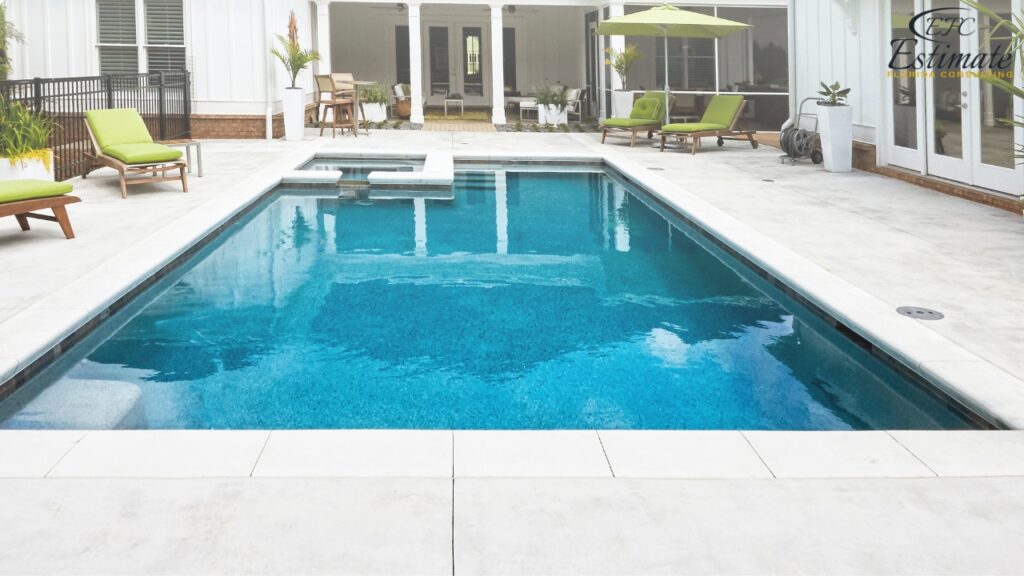
Inground Pools $100,000 and above
A budget of at least $100,000 allows for extensive customization. Many homeowners invest over this amount to achieve their dream pool, incorporating premium upgrades such as water features, custom tiling, landscaping, spa additions, and fencing.
Beyond $75,000, concrete and fiberglass pools tend to be the preferred choices, though vinyl pools remain an option.
Your pool project’s scope and cost can increase significantly based on your specific preferences and needs.
Comparison of Inground Pool Materials
When deciding on an inground pool, the choice of material significantly affects both upfront costs and long-term durability. Here’s a detailed comparison:
Fiberglass
Inground fiberglass pools typically cost between $33,000 and $93,500 installed. They are known for their durability, as fiberglass is a strong and flexible material that can withstand various weather conditions and ground movements without cracking. Fiberglass pools are also pet-friendly, as the smooth surface is less likely to cause scratches compared to concrete or vinyl. Maintenance costs are relatively low due to the non-porous surface, which resists algae and mineral build-up. Unlike vinyl pools, fiberglass pools do not require frequent liner replacements, which can save significant costs over time. However, fiberglass pools are less customizable than concrete, as they come pre-molded from the factory with limited design options.
Concrete
An inground concrete or gunite pool is the most customizable option but also the most expensive, with average costs ranging from $55,000 to $132,000. Concrete pools are highly durable and can last 50+ years with proper maintenance. They can be designed in virtually any shape or size, allowing for intricate features such as tanning ledges, waterfalls, and custom depths. However, concrete pools require more maintenance compared to fiberglass and vinyl. Regular maintenance includes periodic acid wash treatments every 3 to 5 years, which help remove algae and mineral deposits from the porous surface. Additionally, concrete pools need to be resurfaced every 10 to 15 years to maintain their appearance and structural integrity, costing between $8,800 and $11,000 depending on the size of the pool. Despite the higher maintenance costs, many homeowners choose concrete for its aesthetic versatility and long-term durability.
Vinyl
Vinyl inground pools are generally the most affordable option, ranging from $27,500 to $71,500 including installation. They are quick to install compared to fiberglass and concrete, making them a popular choice for budget-conscious homeowners. Vinyl pools have a smooth, non-porous surface that inhibits algae growth initially, but they are more susceptible to punctures, tears, and fading over time. The vinyl liner, which is typically 20-30 mils thick, needs to be replaced approximately every 7 to 10 years, costing between $3,300 and $8,250 depending on the size and complexity of the pool. This periodic replacement cost should be factored into the long-term budget. Vinyl pools offer some design flexibility in terms of shape and size, but they are less customizable than concrete and more limited in design options compared to fiberglass.
Choosing the Right Material
When selecting the material for your inground pool, consider factors such as your budget, desired durability, maintenance preferences, and aesthetic goals. Fiberglass pools are ideal for low-maintenance durability with moderate customization options. Concrete pools offer maximum customization but require higher upfront costs and ongoing maintenance. Vinyl pools provide affordability and ease of installation but require periodic liner replacements and have limitations in design flexibility. Assessing these factors will help you make an informed decision that aligns with your long-term enjoyment and investment in your pool.
Factors Affecting Inground Pool Costs
Several critical factors influence the overall cost of installing and maintaining an inground pool. Here’s a comprehensive breakdown:
Maintenance
Monthly pool maintenance typically ranges from $88 to $165, depending on the pool’s material and size. This cost covers essential tasks such as cleaning, pH balancing with chemicals, seasonal opening and closing procedures, and any necessary repairs. Pools with more complex systems or larger surface areas may incur higher maintenance costs.
Location
Geographic location plays a significant role in determining pool costs. In northern states where pools are less common and weather conditions can be harsh, installation costs tend to be higher due to shorter construction seasons and the need for more robust materials to withstand freezing temperatures. Additionally, if your property is remote or situated on challenging terrain like a steep hill, accessing the site and transporting equipment can increase installation expenses.
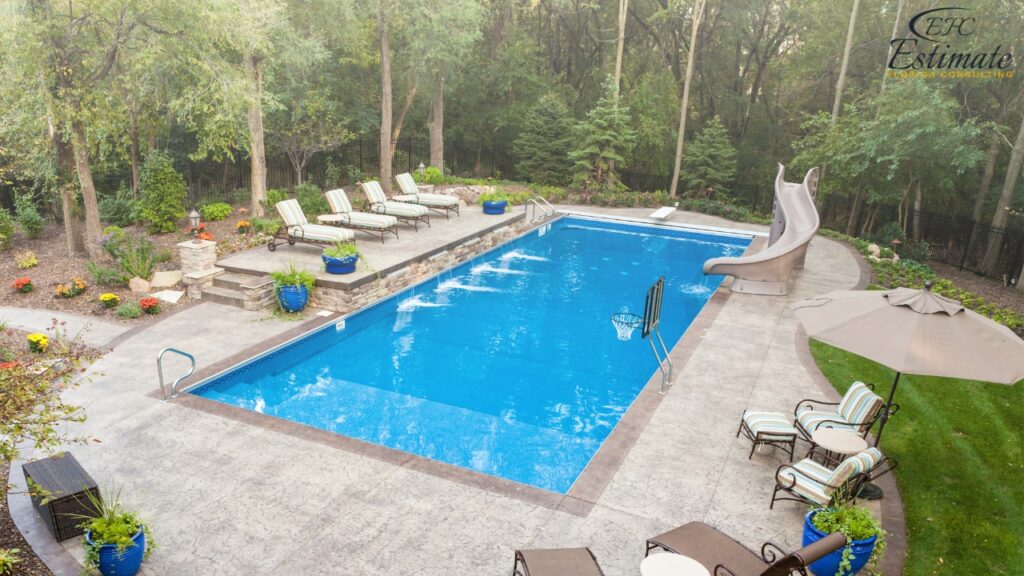
Depth
The depth of an inground pool directly impacts construction costs. Standard pools typically range from 6 to 7 feet deep. However, deeper pools, especially those designed for diving with depths exceeding 9 feet, require more excavation, additional structural support, and increased water volumes. These factors contribute to higher installation costs compared to shallower designs.
Water Type
Switching from a traditional chlorine pool to a saltwater system costs between $1,210 and $2,420 on average. Saltwater pools are favored for their gentler feel on skin and hair, lower maintenance requirements in terms of chemical additives, and reduced chlorine smell. Despite higher upfront conversion costs, many homeowners find long-term savings in reduced chemical purchases and simplified maintenance routines.
Get 5 New Leads Next 7Days With Our System
- Multi-Family Building
- Hotel Building
- Hospital Building
- Warehouse Building
- High-Rise Building
- Shopping Complex
Homeownership Costs
While an inground pool can enhance property value and lifestyle enjoyment, it also introduces ongoing financial considerations. Homeowners should anticipate potential increases in property taxes due to the added property value from the pool installation. Additionally, homeowner’s insurance premiums may rise to cover liability risks associated with pool ownership, such as accidents or injuries.
Winterizing
In regions experiencing cold winters, annual pool winterization is necessary to protect the pool and its equipment from freeze damage. Winterizing procedures typically include lowering the water level, adding winterizing chemicals, clearing water lines, and securing a sturdy pool cover. The cost of winterization services varies based on pool size and local climate conditions but is essential for prolonging the pool’s lifespan and minimizing repair expenses.
Pool Removal
Decommissioning an inground pool involves substantial costs, ranging from $4,400 to $17,600. Factors influencing removal expenses include the pool’s size, depth, and construction materials. Above-ground pools are generally cheaper to remove, with costs typically ranging from $330 to $2,750. Homeowners considering pool removal should factor in the cost of demolishing concrete or gunite structures, disposing of debris, and restoring the landscape.
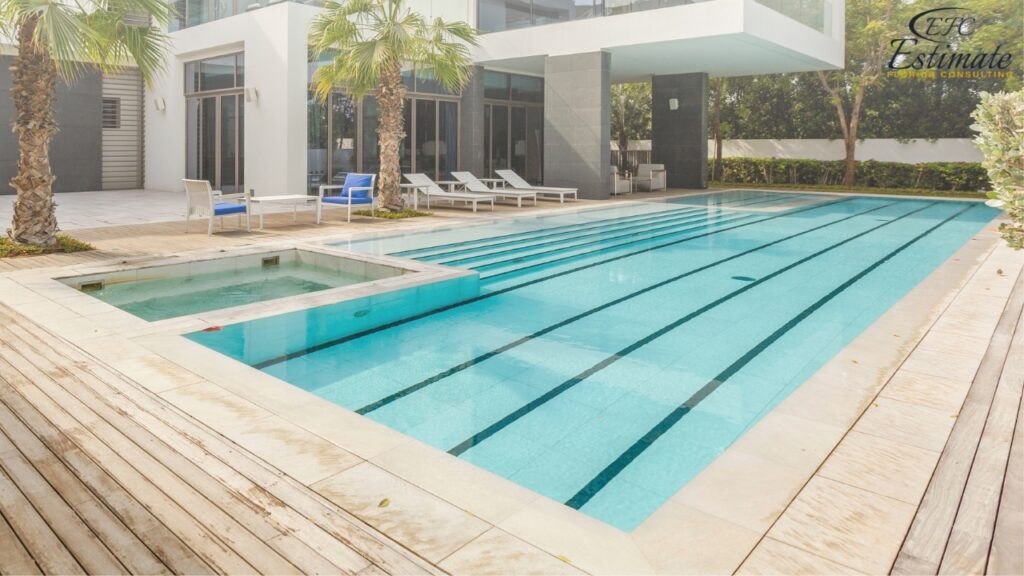
Permit
Obtaining a building permit for an inground pool installation typically costs between $110 and $330. This fee covers the administrative costs associated with reviewing construction plans, ensuring compliance with local building codes, and conducting site inspections during and after installation. Many reputable pool contractors include permit acquisition as part of their service package, simplifying the process for homeowners.
Above-Ground Pool Liner Cost
Every above-ground pool requires a liner to maintain its watertight integrity, with vinyl being the predominant material used. The cost of these liners typically ranges from $110 to $770, depending on several factors:
- Size of the Pool: Larger pools naturally require more material, thus increasing the cost of the liner.
- Shape of the Bottom Surface: Pools with irregular or complex bottom shapes may require custom liners, which can be more expensive than standard ones.
- Type of Liner: Different types of liners come with varying costs based on their design and installation method.
- Ease of Installation: Some liner types are easier to install than others, affecting both the installation time and potential labor costs.
Here’s an overview of the most common types of above-ground pool liners and their characteristics:
Overlap Liners
Overlap liners are the most straightforward option, extending over the pool’s top edge and secured with coping strips. They are relatively easy to install and are typically priced between $110 and $440. While functional, they may not offer the most aesthetically pleasing finish compared to other liner types.
Beaded Liners
Beaded liners feature a bead or hook along their top edge, which snaps into a track or receiver on the inside of the pool wall. This installation method provides a cleaner look since the liner edge is hidden, enhancing the pool’s appearance. Beaded liners generally cost between $165 and $550, reflecting their enhanced aesthetics and secure fit.
Unibead Liners
Unibead liners combine the features of both beaded and overlap liners, offering versatility in installation. They can function as either a beaded liner (secured by a track) or a J-hook liner (hooked over the pool wall). This flexibility makes them suitable for various pool designs and typically ranges in price from $220 to $1,100, depending on the specific installation method chosen.
J-Hook Liners
J-hook liners have a specially designed hook shape at the top edge that hooks onto the pool’s top rail. This ensures a snug and secure fit without the need for additional coping strips or bead receivers. J-hook liners are tailored to fit specific pool models precisely and are priced approximately between $330 and $990, reflecting their custom design and ease of installation.
Expandable Liners
Expandable liners are designed to stretch and conform to the shape and depth of the pool. They are ideal for pools with unusual shapes or deeper bottoms that require more flexibility. Expandable liners typically cost between $220 and $1,100, offering adaptability to various pool configurations.
Choosing the right type of liner involves considering not only the initial cost but also factors such as ease of installation, aesthetic preferences, and compatibility with your pool’s design. Investing in a quality liner ensures both the functionality and visual appeal of your above-ground pool for years to come.
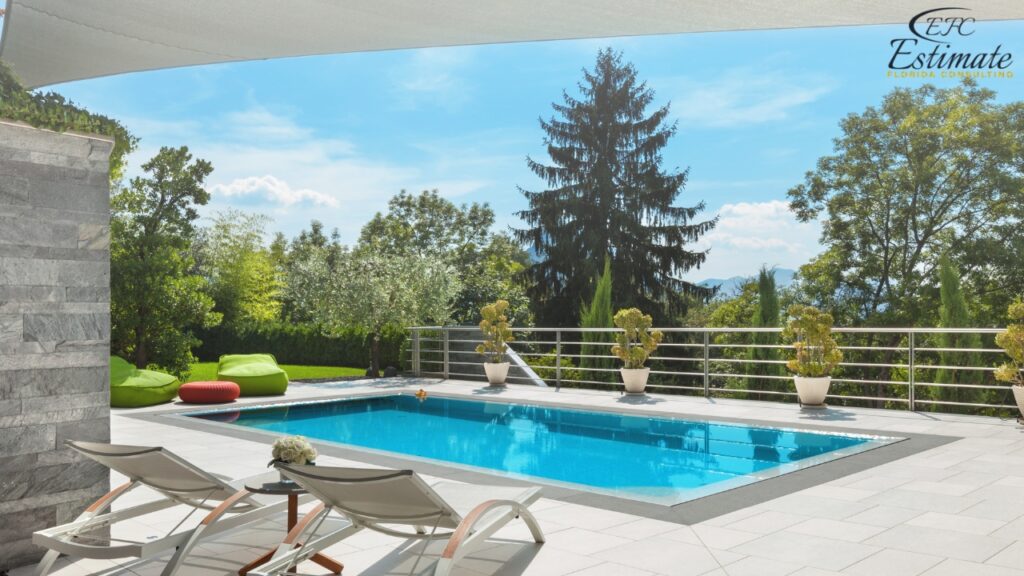
Above-Ground Pool Add-On Costs
When planning your above-ground pool, it’s crucial to consider various add-ons that can enhance both functionality and enjoyment:
Heating
Heating systems for above-ground pools typically range from $225 to $3,993, depending on the type and size of the pool. While not essential, heaters significantly extend the swimming season by maintaining comfortable water temperatures. Gas heaters are generally cheaper to install upfront but can be more expensive to operate over time due to fuel costs. Electric heaters, although pricier initially, are more energy-efficient and cost-effective in the long run.
Filtration
Pool filtration systems are essential for maintaining clean and clear water. Above-ground pool filters range from $363 to $1,089, with options like sand filters, which are cost-effective but require regular backwashing, and cartridge filters, which offer finer filtration and less maintenance. Choosing the right filter depends on your pool size, maintenance preferences, and water clarity goals.
Covers
Pool covers serve multiple purposes, including reducing heat loss, minimizing debris accumulation, and enhancing safety. Automatic pool covers, which can be operated with the push of a button, are the most convenient but also the most expensive, costing $14,520 or more. Solar covers, priced between $264 and $990, not only help retain heat but also reduce heating costs by harnessing solar energy. Choosing a cover depends on your climate, pool usage habits, and budget.
Lighting
Adding lighting to your pool area enhances safety and extends swimming hours into the evening. LED lights are popular for their energy efficiency and color options, ranging from $533 to $1,198. Fiber optic lights, offering similar aesthetics with different installation requirements, cost between $1,198 and $1,997. The choice between LED and fiber optic lights depends on your aesthetic preferences, budget, and desired lighting effects.
Water Features
Water features like fountains or waterfalls can transform your pool into a tranquil retreat. Costs for water features vary widely based on size, complexity, and materials, ranging from $66 for basic fountain features to over $10,648 for elaborate waterfall designs. On average, homeowners invest between $1,122 and $5,993 to install water features, which add visual appeal and soothing sounds to the pool environment.
Each add-on offers distinct advantages in terms of functionality, aesthetics, and maintenance requirements. By carefully considering your priorities and budget, you can customize your above-ground pool to create a comfortable, enjoyable space that meets your family’s needs throughout the swimming season and beyond.
Less Common Pool Types
Exploring beyond the ordinary, there are several types of pools that offer unique features and aesthetics, each varying in cost and suitability:
Semi-Inground Pools
A semi-inground pool typically costs between $9,317 and $30,250 on average. These pools are partially installed above and partially below ground level, making them ideal for yards with sloped terrain or limited space. They provide a more integrated look than above-ground pools while being more affordable than fully inground options. Semi-inground pools can blend seamlessly with landscaping and are available in various shapes and sizes to suit different preferences.
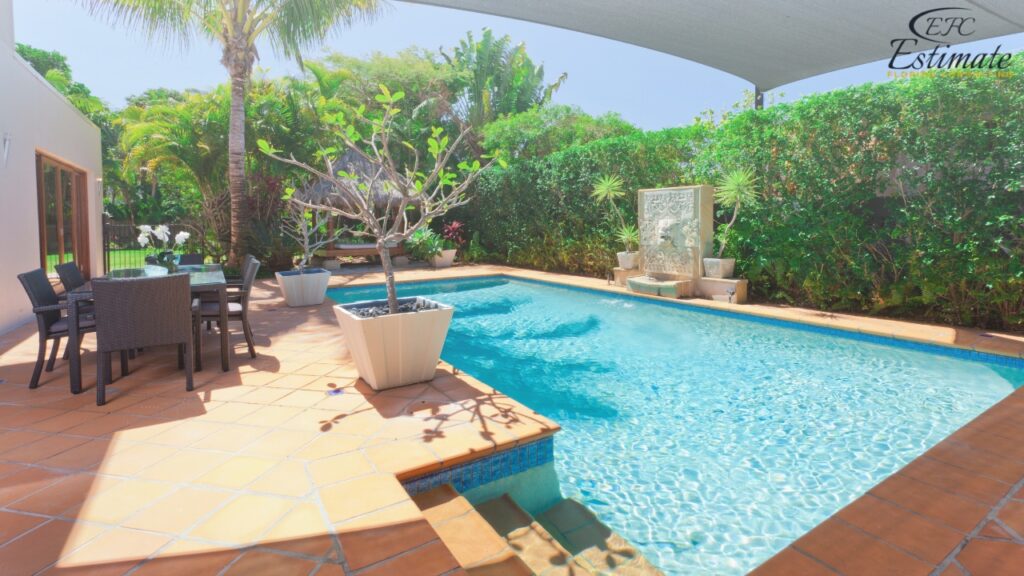
Lap Pools
Inground lap pools are designed for serious swimmers looking to exercise and improve their swimming skills. They range in cost from $53,240 to $93,170, depending on size, depth, and material. Typically rectangular in shape, lap pools are longer and narrower than traditional pools, measuring around 8 to 10 feet wide and 44 to 82 feet in length. The depth ranges from 4 to 9 feet, providing a consistent depth for uninterrupted swimming laps.
Small / Mini Pools
Small inground pools, also known as plunge pools or cocktail pools, cost between $9,317 and $30,250, depending on size and features. These compact pools are gaining popularity for their versatility and space-saving benefits. Common sizes include 6′ x 6′, 11′ x 18′, and 11′ x 22′, with depths ranging from 4 to 7 feet. Mini pools are perfect for relaxation, hydrotherapy, and socializing in smaller backyards or urban settings.
Infinity Pools
Infinity pools, also referred to as zero-edge pools or vanishing edge pools, are a pinnacle of luxury and visual appeal. They typically cost between $73,205 and $172,030. Infinity pools create a striking visual effect by appearing to merge with the horizon, giving an illusion of an endless expanse of water. Some designs include a vanishing edge on one or more sides, often complemented by waterfalls or intricate landscaping to enhance their aesthetic impact.
Cost of Inground Pool Upgrades
Enhancing your inground pool with custom upgrades adds both luxury and functionality but comes with additional costs and considerations. Here are detailed insights into common upgrades to consider:
Custom Shapes
While rectangular or oval pools are more budget-friendly, custom-shaped pools like freeform, lagoon, L-shaped, kidney-shaped, or geometric designs offer unique aesthetics and spatial configurations. These shapes can range in cost due to their complexity, with freeform and irregular shapes typically costing more than standard shapes due to additional excavation and construction requirements. Custom shapes allow for personalized landscaping around the pool and can accommodate specific architectural styles or backyard layouts. Expect costs to range from $11,396 to $33,275 for custom-shaped pools, depending on size and complexity.
Waterfalls
Adding a pool waterfall enhances the visual appeal and creates a relaxing atmosphere with the soothing sound of flowing water. The cost varies significantly based on the type and size of waterfall. A sheer descent or sheet waterfall, which provides a smooth, continuous flow of water, costs between $585 and $2,343 on average. For those desiring a more natural look, a rock waterfall ranges from $2,200 for faux rock to $26,329 for a large, intricate waterfall made from real stone. The choice of materials and design complexity affects both the initial cost and long-term maintenance of the waterfall feature.
Beach Entry
Also known as zero-entry pools, these designs feature a gradual slope instead of traditional steps, resembling a natural beach or shore entry. Beach entry pools are ideal for families with young children or individuals who prefer easy access to the water. Costs for beach entry pools average $72 to $184 per square foot, factoring in specialized construction techniques to achieve the gradual slope seamlessly. The design enhances safety and accessibility while providing a spacious area for lounging or recreational activities near the pool’s edge.
Hot Tub
Integrating an inground hot tub enhances relaxation and adds versatility to your pool area. Hot tubs are available as standalone features or can be integrated into the pool design during construction. Costs for standalone hot tub installations range from $11,713 to $36,603, while including a hot tub during initial pool construction costs between $8,784 and $21,861. Hot tubs provide therapeutic benefits through hydrotherapy and are equipped with heating systems that increase monthly operating costs by $44 to $145, depending on usage and local energy rates.
Lights
Inground pool lighting enhances safety and extends usability into the evening hours, enhancing the pool’s ambiance and visual appeal. Costs for pool lights range from $1,030 to $2,635, depending on the type and technology chosen. LED lights are energy-efficient and offer customizable color options, with installation costs ranging from $532 to $1,438. Fiber optic lights provide dynamic lighting effects and range from $1,198 to $2,635, offering versatility in creating mood lighting or highlighting architectural features. Installing lights during pool construction minimizes installation costs and disruption compared to retrofitting them later.
Diving Board or Slide
Adding a diving board or slide enhances the recreational value of your inground pool, providing entertainment for swimmers of all ages. Surface-mounted diving boards range from $439 to $980, offering traditional fun and requiring sturdy anchoring for safety. Pool slides, which vary in design complexity and material quality, cost between $1,464 and $5,764, contributing to the pool’s appeal with thrilling water activities. Proper installation ensures safety and durability, with options available to suit different pool sizes and user preferences.
Pool Heater
Installing a pool heater extends the swimming season and ensures comfortable water temperatures year-round. Costs for inground pool heaters range from $2,343 to $7,613, depending on the heater type and pool size. Gas heaters, priced between $3,005 and $9,597, provide rapid heating capabilities suitable for cooler climates. Solar pool heaters, ranging from $3,660 to $9,517, utilize renewable energy from the sun and are cost-effective for maintaining pool temperatures in sunny regions. Heater installation costs include labor and materials, with operational costs influenced by energy efficiency and local utility rates.
Landscaping
Enhancing your pool area with landscaping creates a cohesive outdoor environment that complements your pool’s design and enhances overall aesthetics. Landscaping costs range from $4,392 to $7,261 on average, or $6 to $18 per square foot, depending on the scope of work and materials selected. Popular landscaping styles include tropical, modern, and desert themes, incorporating plants, trees, and shrubs that provide shade, privacy, and visual interest. Professional landscaping enhances the pool area’s functionality and attractiveness, creating an inviting space for relaxation and entertainment.
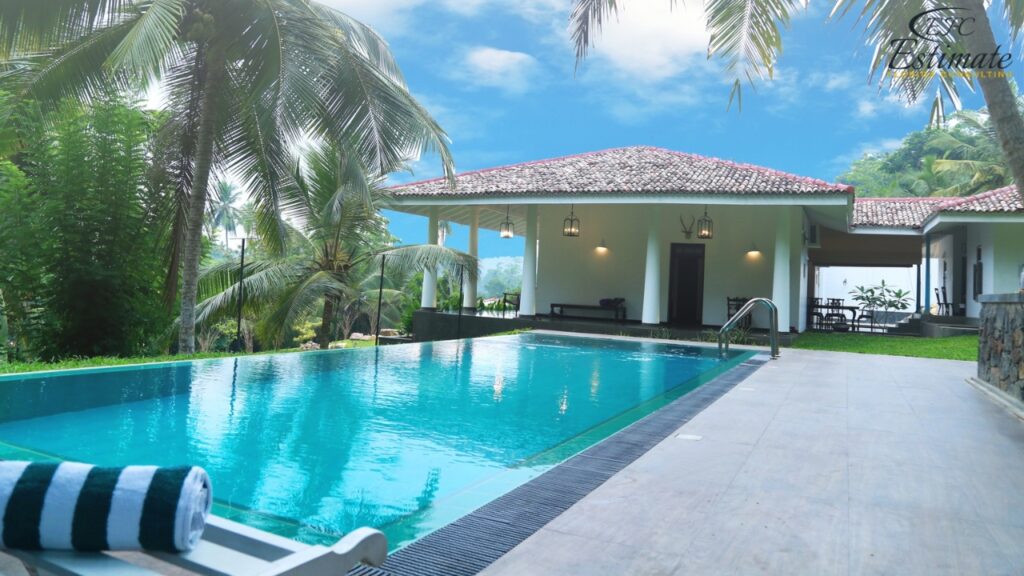
By carefully selecting and integrating these upgrades, you can customize your inground pool to reflect your personal style and enhance the functionality of your outdoor living space. Each upgrade contributes to the overall enjoyment and value of your property, creating a luxurious retreat for family gatherings, leisure activities, and relaxation throughout the year.
Advantages of Above-Ground Pools
Above-ground pools present several advantages that make them a compelling choice for many homeowners:
- Cost-Effectiveness: Above-ground pools are significantly more affordable than their in-ground counterparts. On average, an above-ground pool costs about $2,850, whereas an in-ground pool can set you back around $51,833. This substantial cost difference makes above-ground pools much more accessible to families looking to enjoy the benefits of a swimming pool without the hefty price tag.
- Enhanced Aesthetics: While plain above-ground pools might not initially impress, they can be transformed into attractive features of your backyard with the right enhancements. Adding quality decking, landscaping, and even integrating it into your overall outdoor design can elevate the appearance of an above-ground pool to a level that rivals traditional in-ground options. With creative planning, you can achieve a look that is both functional and aesthetically pleasing.
- Hydrotherapy and Relaxation: Many above-ground pools offer enough space for various water activities, including water aerobics, which can provide excellent hydrotherapy benefits. Even for casual users, the simple act of relaxing in the water can promote relaxation and stress relief, making an above-ground pool a valuable addition for both physical health and overall well-being.
- Affordable Luxury: Opting for an above-ground pool not only saves on upfront costs but also allows you to allocate your savings towards enhancing the pool area further. This could include investing in quality landscaping, installing attractive lighting, constructing a spacious deck around the pool, or adding other features that enhance the overall enjoyment and aesthetic appeal of your outdoor space.
In conclusion, if your primary goal is to enjoy the benefits of a pool for personal use and relaxation, an above-ground pool offers a practical and cost-effective solution that can rival the enjoyment of an in-ground pool at a fraction of the cost.
Above-Ground vs. In-Ground Pools
Choosing between an above-ground and in-ground pool depends on various factors, including your budget, property layout, and aesthetic preferences:
- Cost Comparison: Above-ground pools typically range from $1,000 to $3,000, depending on size and features, while in-ground pools generally cost between $28,000 and $55,000. The cost per square foot for above-ground pools averages around $12, whereas in-ground pools can cost approximately $125 per square foot due to excavation, construction, and finishing costs.
- Design and Aesthetics: Many modern above-ground pool designs mimic the appearance of in-ground pools, especially when paired with a raised deck. This integration can create a seamless transition between the pool and the surrounding landscape, enhancing the overall visual appeal of your outdoor area.
- Long-Term Value: While above-ground pools are more affordable upfront, in-ground pools are often considered an investment that can potentially increase the resale value of your home. They are typically seen as permanent fixtures that add significant aesthetic and functional value to a property, especially in real estate markets where pools are highly desirable.
Download Template For Pool Project Breakdown
- Materials list updated to the zip code
- Fast delivery
- Data base of general contractors and sub-contractors
- Local estimators

Conclusion
Inground pools offer a range of options and costs depending on your budget and preferences. Starting with basic vinyl liner pools at approximately $49,500, costs can escalate to $77,000 or more with added features like heaters and fencing. Fiberglass pools begin around $60,500 for similar dimensions, providing a mid-range alternative to vinyl. Concrete pools, while the most customizable, start at about $71,500 but can exceed this depending on customization and complexity. Factors such as location, pool size, and additional features like retaining walls significantly impact overall costs. Ultimately, your choice should align with both your budgetary constraints and long-term goals for enhancing your property’s value and recreational appeal.
FAQs
We offer a comprehensive range of exterior painting services, including residential, commercial, and industrial painting. Our services cover everything from single-family homes to large commercial buildings and everything in between.
Signs that your exterior might need painting include peeling or blistering paint, faded or discolored paint, cracks or damage to the surface, or if it’s been more than 5-7 years since your last paint job. Our experts can also assess your property and provide recommendations.
We are experienced in painting a variety of exterior surfaces, including wood, stucco, brick, concrete, metal, vinyl, and more. Our team has the expertise and equipment to handle any surface effectively.
The duration of the project depends on various factors, such as the size of the property, the condition of the existing paint, weather conditions, and any necessary preparations or repairs. We will provide you with a detailed timeline during the estimate phase.
We use high-quality paints from trusted brands that are known for their durability and longevity. However, if you have specific preferences or requirements, we are happy to accommodate them.
Yes, all our painters are fully licensed, bonded, and insured. We prioritize the safety of our team and your property, and we adhere to all safety regulations and industry standards.
Yes, we stand behind the quality of our workmanship. We offer a warranty on both labor and materials used for our exterior painting projects. Please ask for specific warranty details during the estimate process.
Google Reviews



Process To Get Pool Cost Estimate Report
Here I am going to share some steps to get your pool cost estimate report.
-
You need to send your plan to us.
You can send us your plan on info@estimatorflorida.com
-
You receive a quote for your project.
Before starting your project, we send you a quote for your service. That quote will have detailed information about your project. Here you will get information about the size, difficulty, complexity and bid date when determining pricing.
-
Get Estimate Report
Our team will takeoff and estimate your project. When we deliver you’ll receive a PDF and an Excel file of your estimate. We can also offer construction lead generation services for the jobs you’d like to pursue further.

